Book contents
- Frontmatter
- Contents
- Preface
- 1 Introduction
- 2 Basic facts about optics
- 3 Basic facts from electromagnetism
- 4 Slab waveguides
- 5 Linear optical fibre and signal degradation
- 6 Propagation of linear pulses
- 7 Optical sources
- 8 Optical amplifiers and EDFA
- 9 Semiconductor optical amplifiers (SOA)
- 10 Optical receivers
- 11 Finite difference time domain (FDTD) formulation
- 12 Beam propagation method (BPM)
- 13 Some wavelength division multiplexing (WDM) devices
- 14 Optical link
- 15 Optical solitons
- 16 Solar cells
- 17 Metamaterials
- Appendix A Basic MATLAB
- Appendix B Summary of basic numerical methods
- Index
14 - Optical link
Published online by Cambridge University Press: 05 July 2013
- Frontmatter
- Contents
- Preface
- 1 Introduction
- 2 Basic facts about optics
- 3 Basic facts from electromagnetism
- 4 Slab waveguides
- 5 Linear optical fibre and signal degradation
- 6 Propagation of linear pulses
- 7 Optical sources
- 8 Optical amplifiers and EDFA
- 9 Semiconductor optical amplifiers (SOA)
- 10 Optical receivers
- 11 Finite difference time domain (FDTD) formulation
- 12 Beam propagation method (BPM)
- 13 Some wavelength division multiplexing (WDM) devices
- 14 Optical link
- 15 Optical solitons
- 16 Solar cells
- 17 Metamaterials
- Appendix A Basic MATLAB
- Appendix B Summary of basic numerical methods
- Index
Summary
In the present chapter we will combine some of the methods developed earlier to create the simple point-to-point optical simulator which represents the simplest photonic system. It involves the transmitter, optical fibre and receiver. Some issues of how to quantify the quality of transmission in such a system will also be reviewed. Performance evaluation and tradeoff analysis are the central issues in the design of any communication system. Using only analytical methods, it is practically impossible to evaluate realistic communication systems. One is therefore left with computer-aided techniques.
In the last 10–15 years the design of photonic systems has moved from the back-of-the-envelope calculations to the use of sophisticated commercial simulators, see for example, products advertised by Optiwave, like OptiSystem [1], by RSoft Design Group the Optical Communication Design Suite [2] and by VPI Photonics line of products [3], to just name a few important players. They contain sophisticated physical models and allow for rapid assessment of new component technologies in the system under design.
Around 1995 the design of optical communication systems (operating over medium distances) would involve only a balance of power losses and pulse spreading. Later on, the demand on billion-dollar systems required complex analysis during the design process. This in turn created the need for sophisticated simulators.
Computer simulations can quickly provide answers to several important questions essential to every engineer designing optical communication system, like: what repeater spacing is needed for a given bit rate, or what is the required power generated by a transmitter?
- Type
- Chapter
- Information
- Computational PhotonicsAn Introduction with MATLAB, pp. 331 - 350Publisher: Cambridge University PressPrint publication year: 2013



